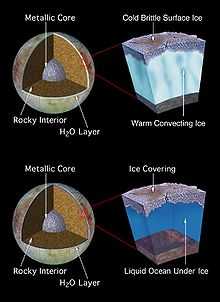Liquid water on Europa

Two possible models of the interior of Europa
Jupiter's moon Europa probably contains liquid water. The laws of electromagnetism stipulate that a varying magnetic field induces a magnetic field if the body withing the varying field is conductive. Europa is within Jupiter's magnetic field and the Galileo probe's measurements of Europa's induced magnetic field suggest there is a global conductive layer near the icy surface. The best possibility to explain this would be a below surface salty ocean.[1]
Discovery
- Discovered by: G. Galilei
 Galileo Galilei, the person who discovered Europa, one of Jupiter's moons
Galileo Galilei, the person who discovered Europa, one of Jupiter's moons - S. Marius
- Discovery date: January 7, 1610
Orbital characteristics
- Epoch January 8, 2004
- Periapsis: 664862 km
- Apoapsis: 676938 km
- Mean radius of orbit: 670,900 km
- Eccentricity: 0.009
- Orbital period: 3.551181 d
- Avg. orbital speed: 13.740 km/s
- Inclination: 0.470° (to Jupiter's equator)
- Satellite of: Jupiter
Physical characteristics
- Mean radius: 1,569 km (0.245 Earths)
- Surface area: 3.09×107 km² (0.061 Earths)
- Volume: 1.593×1010 km³ (0.015 Earths)
- Mass: 4.80×1022 kg (0.008 Earths)
- Mean density: 3.01 g/cm³
- Equatorial surface gravity: 1.314 m/s² (0.134 g)
- Escape velocity: 2.025 km/s
- Rotation period: Synchronous
- Axial tilt: 0.1°
- Albedo: 0.67 ± 0.03
- Surface temp: 50 K~125K
- Apparent magnitude: 5.29 (opposition)
Atmosphere
- Surface pressure: 1 µPa
References
- ↑ http://web.archive.org/web/20040227211454/http://www.space.com/searchforlife/seti_phillips_europa_040226.html
See also
- School:Astronomy
External links
This article is issued from Wikiversity - version of the Monday, August 17, 2015. The text is available under the Creative Commons Attribution/Share Alike but additional terms may apply for the media files.